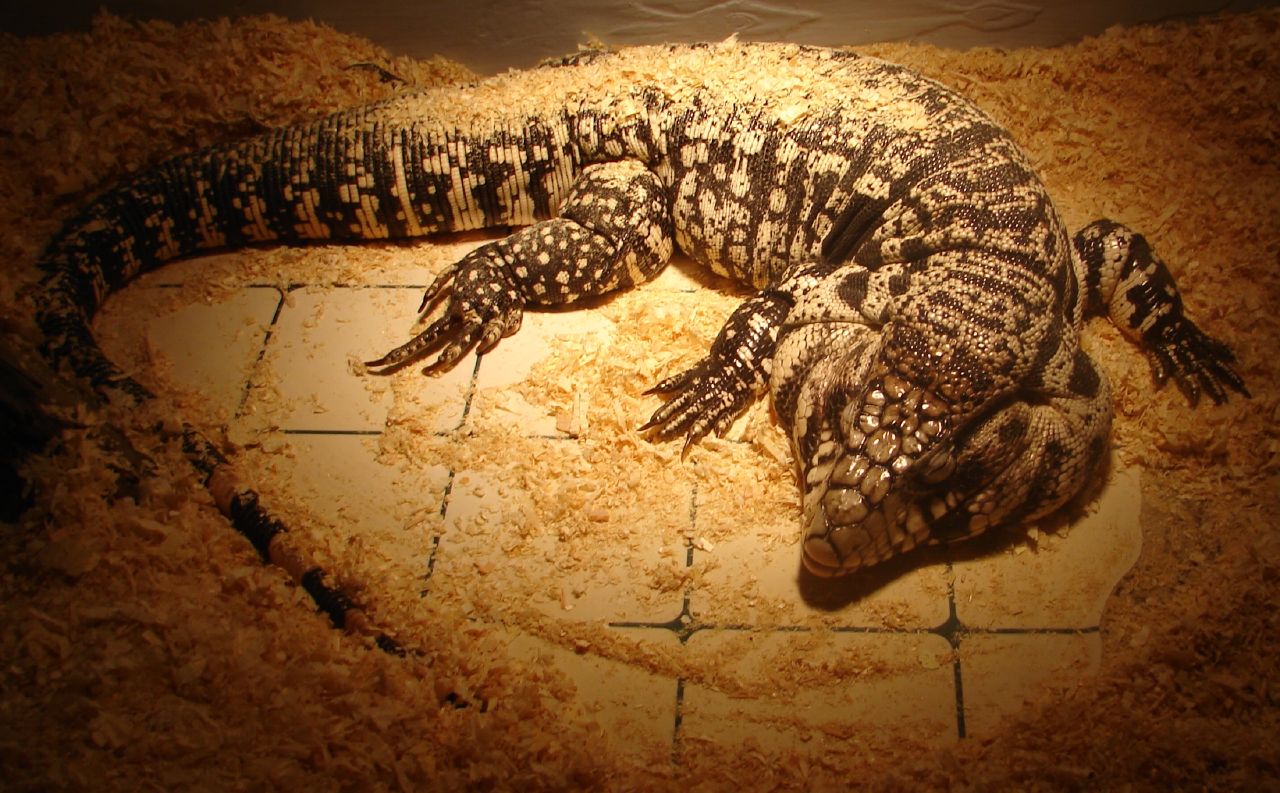- Argentine Black and White Tegu
Taxobox
name = Argentine Black and White Tegu

image_width = 240px
regnum =Animal ia
phylum = Chordata
classis = Reptilia
ordo =Squamata
subordo =Sauria
familia =Teiidae
genus = "Tupinambis "
species = "T. merianae"
binomial = "Tupinambis merianae"
binomial_authority = Linnaeus, 1758
synonyms =See textThe Argentine Black and White Tegu, ("Tupinambis merianae"), is the largest species of tegu. It belongs to the teiid family. It was long believed the
scientific name "Tupinambis teguixin" referred to this species, but it is today used for theGold Tegu .Its life span is about fifteen to twenty years. This terrestrial species inhabits the tropical
rain forest s of East and CentralSouth America . Individuals of this species like dense foliage and forage for food, of which they consume as much as possible before going into hibernation in autumn. [ [http://www.boaddiction.com/archive/index.php/t-244.html Tegu care sheet. [ArChive - Boaddiction ] ] They also exhibit an unusually high level of intelligence among reptiles, along with a high level of physical activity during the wakeful period of the year.Appearance
The Argentine tegu reaches lengths of 4 to 5.5 feet at maturity. Males are much larger and heavier than females, and develop jowls as they mature. The sex of an Argentine tegu can be found by looking at the vent and searching for two raised bump-like features. Hatchlings are bright green with black markings; the green fades to white within a couple of months.
In captivity
Argentine tegus make good pets, as they have a tendency to become attached to their owners and are generally quite docile as adults. Additionally, some Argentines have been trained to use litter boxes.
Housing
In captivity, adults require a large enclosure, 8'L x 3' W x 18" H at the smallest. [ [http://www.reptilia.org/care_sheets/lizards/csheets_liz_argtegu.htm ::: [ R:e:p:t:i:l:i:a ::: ] ] Because of the large caging requirements, it is considered best to build one's own cage. Use full spectrum lighting 12-14 hours per day. Putting a bulb on fine screen will filter out more than 50% of the useful rays, and the rays will not penetrate glass,
acrylic glass or plastic. The light should be mounted inside the tank with a half by half inch or similar guard so the lizard does not hurt itself. Also, most UVA bulbs do not provide UVB, so read the label carefully. They need to be replaced every year, so write the date on the bulb.Provide a basking area with a temperature of about 90-100 degrees Fahrenheit with access to a cooler zone. These animals are burrowers, and should be provided with plenty of substrate for digging. They will sometimes build burrows and the substrate should be at least six inches deep to facilitate this. Temperatures during the day should be gradient from 80 to 90 °F. Maintain the night temperature range between 72-80 °F. If necessary, use reptile heating pads under tank for 24-hour heat. Alternately, a ceramic heat emitter can be used and is especially versatile, as it can be used at all times without disrupting the tegu's
photoperiod . This species requires moderate to high levels of humidity for proper shedding. Frequent misting of the tank is recommended.The best and most common substrate for tegus is cypress mulch, as it holds moisture well and resists mold and decay. [ [http://www.mulch.com/aboutmulch.asp#cypress About Mulch ] ]
Feeding
Tegus are prone to food aggression; they will quickly learn to associate human presence with food, and may turn their enthusiastic feeding response upon their caretakers if certain precautions are not taken. Bowl feeding, if the same bowl is used every day, will cut down on aggression as the tegu learns to associate the bowl, and not its owner's hand, with feeding time. This will also prevent accidental ingestion of substrate, which can result in
impaction , a serious health risk for reptiles. Feeding in a separate area outside the enclosure is another way to accomplish both of these aims.This tegu is primarily a
carnivore . Young animals are entirely carnivorous, but will accept, and must be given, fresh fruit and vegetables as they mature. Their diet should mainly consist of appropriate sizedinsects , raw meat such aschicken orturkey , and cooked eggs. Wholerodents are also a good source of nutrients, but should be given somewhat sparingly, as they are high in fat; tegus are prone to obesity and will happily over-eat if allowed. Supplementing their diet with a mineral and vitamin powder is beneficial. Always offer variety for proper nutrition. [ [http://lllreptile.com/info/library/animal-care-sheets/lizards-and-monitors/-/argentine-black-and-white-tegu/ Argentine Black & White Tegu ] ]References
External links
* [http://www.tegutalk.com/ TeguTalk.com: Reptile Forums and Chatroom] (Experienced care and advice from Tegu owners across the world)
* [http://www.boaddiction.com/archive/index.php/t-244.html Tegu care sheet]
* [http://centralpets.com/animals/reptiles/lizards/lzd6033.html Giant tegu]
* [http://www.reptilia.org/care_sheets/lizards/csheets_liz_argtegu.htm Argentine Tegu - Tupinambis merianae]
* [http://lllreptile.com/info/library/animal-care-sheets/lizards-and-monitors/-/argentine-black-and-white-tegu/ LLLReptile Argentine Tegu Caresheet]
* [http://www.reptileallsorts.com/black-white-tegus.htm Keeping and Breeding the Argentine Black and White Tegu]
Wikimedia Foundation. 2010.
